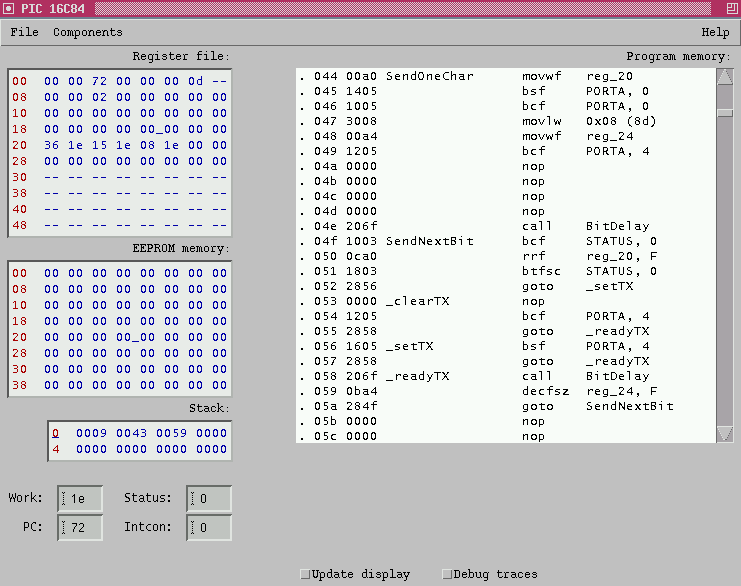

Applets
contents
visual index
 introduction
introduction std_logic_1164
std_logic_1164 gatelevel circuits
gatelevel circuits delay models
delay models flipflops
flipflops adders and arithm...
adders and arithm... counters
counters LFSR and selftest
LFSR and selftest memories
memories programmable logic
programmable logic state-machine editor
state-machine editor misc. demos
misc. demos I/O and displays
I/O and displays DCF-77 clock
DCF-77 clock relays (switch-le...
relays (switch-le... CMOS circuits (sw...
CMOS circuits (sw... RTLIB logic
RTLIB logic RTLIB registers
RTLIB registers Prima processor
Prima processor D*CORE
D*CORE MicroJava
MicroJava Pic16 cosimulation
Pic16 cosimulation
 PIC16C84 dem...
PIC16C84 dem...
 fast PIC16C8...
fast PIC16C8...
 interrupt-dr...
interrupt-dr...
 on-chip timer
on-chip timer
 EEPROM access
EEPROM access
 EEPROM access
EEPROM access
 RS-232 trans...
RS-232 trans...
 software RS-232
software RS-232
 software RS-...
software RS-...
 chronograph
chronograph
 MIDI footswi...
MIDI footswi...
 MIDI footswi...
MIDI footswi...
 MIDI footswi...
MIDI footswi...
 MIDI organ p...
MIDI organ p...
 MIDI organ p...
MIDI organ p...
 ultrasonic r...
ultrasonic r...
 ultrasonic r...
ultrasonic r...
 "Phrasendres...
"Phrasendres...
 "mastermind"...
"mastermind"... Mips R3000 cosimu...
Mips R3000 cosimu... Intel MCS4 (i4004)
Intel MCS4 (i4004) image processing ...
image processing ... [Sch04] Codeumsetzer
[Sch04] Codeumsetzer [Sch04] Addierer
[Sch04] Addierer [Sch04] Flipflops
[Sch04] Flipflops [Sch04] Schaltwerke
[Sch04] Schaltwerke [Sch04] RALU, Min...
[Sch04] RALU, Min... [Fer05] State-Mac...
[Fer05] State-Mac... [Fer05] PIC16F84/...
[Fer05] PIC16F84/... [Fer05] Miscellan...
[Fer05] Miscellan... [Fer05] Femtojava
[Fer05] Femtojava FreeTTS
FreeTTS

The right part of the window shows the program memory with addresses, raw memory data, and disassembled instructions. You can click the leftmost column to set and clear program breakpoints. The current intruction is highlighted in green color. The left part of the window shows (from top to bottom) the data memory, on-chip EEPROM memory, internal subroutine stack, and the current values of the four most important registers (work register, program-counter, status register, interrupt control). All special-function registers in the PIC architecture are directly memory-mapped into the data-memory. If you want to change the memory contents or a register value, just type-in new hex-values into the data memory.
However, note that the simulation runs very slowly while the PIC GUI window is open and enabled, because most of the processor time is spent redrawing the processor register and memory windows. Uncheck the 'update' checkbox to disable redrawing of the registers to watch the simulation at normal speed.
The speed of the nightrider animation depends on the wait loops in the PIC microcontroller program, whose limits were set during assembly. If the simulation runs too slow (or fast :-)), you can edit the assembly code and re-assemble, or open the microcontroller GUI and change the values of the wait loop initialization manually. The correspondingmovlw C8 instructions are
at program addresses 00F and 001
and load the value C8 first into the W register.
You can change those instructions to something like movlw 10
to reduce the wait counter initialization value,
which makes the animation much faster.
For reference, here is the original program:
;*******************************************************************
; walk.asm
;
; This code walks LEDs backwards and forwards on port b.
; Couldn't be simpler.
;*******************************************************************
LIST P=16C84;f=inhx8m
_CP_OFF equ H'3FFF' ;code protect off
_PWRTE_ON equ H'3FFF' ;Power on timer on
_WDT_OFF equ H'3FFB' ;watch dog timer off
_XT_OSC equ H'3FFD' ;crystal oscillator
__CONFIG _CP_OFF & _PWRTE_ON & _WDT_OFF & _XT_OSC
;configure programmer directive
w equ 0 ; register destination numbers.
f equ 1
same equ 1
z equ 2 ; status flags
zero equ 2
c equ 0
carry equ 0
count1 equ 0C ; wait counter ls digit file register C
count2 equ 0D ; wait counter ms digit file register D
portb equ 06 ; port b I/O register f6
porta equ 05 ; port a I/O register f5
status equ 03 ; status register f3
;
;
;
org 0 ; origin
;
init
movlw 0
tris portb ; set portb as outputs
movwf portb ; set portb levels all low
start
bsf portb,0 ; set portb bit 0 high
rot_L call wait ; wait for a bit
bcf status,c ; clear carry bit
rlf portb,same ; rotate left portb, store result portb
btfss portb,7 ; skip next line if top bit set
goto rot_L
rot_R call wait ; wait for a bit
bcf status,c ; clear carry bit
rrf portb,same ; rotate right portb, store in portb
btfss portb,0 ; skip next line if bottom bit set
goto rot_R
goto rot_L ; do it all again
; ----------------------------
; wait subroutine
; ----------------------------
wait
movlw .200 ; load count1 with decimal 200
movwf count1
d1 movlw .200 ; load count2 with decimal 200
movwf count2
; shorten these for the simulator
d2 decfsz count2,same ; decrement and skip next line if zero
goto d2 ; if not zero
decfsz count1 ; decrement count1 if count2 is zero
goto d1 ; do inside loop again if count2 nz
retlw 00
; ----------------------------
END